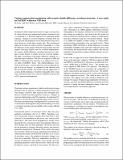Carbon sequestration monitoring with acoustic double-difference waveform inversion: A case study on SACROC walkaway VSP data
Author(s)
Yang, Di; Fehler, Michael; Malcolm, Alison E.; Huang, Lianjie
DownloadYang_DDInv.pdf (458.6Kb)
Other Contributors
Massachusetts Institute of Technology. Earth Resources Laboratory
Metadata
Show full item recordAbstract
Geological carbon sequestration involves large-scale injection of carbon dioxide into underground geologic formations and is considered as a potential approach for mitigating global warming. Changes in reservoir properties resulting from the CO[subscript 2] injection and migration can be characterized using waveform inversions of time-lapse seismic data. The conventional approach for analysis using waveform tomography is to take the difference of the images obtained using baseline and subsequent time-lapse datasets that are inverted independently. By contrast, double-difference waveform inversion uses timelapse seismic datasets to jointly invert for reservoir changes. We apply conventional and double difference methods to a field time-lapse walkaway VSP data set acquired in 2008 and 2009 for monitoring CO[subscript 2] injection at an enhanced oil recovery field at SACROC, Texas. The double-difference waveform inversion gives a cleaner and more easily interpreted image of reservoir changes, as compared to that obtained with the conventional scheme. Our results from the application of acoustic double-difference waveform tomography shows some zones with decreased P-wave velocity within the reservoir due to CO[subscript 2] injection and migration.
Date issued
2011Publisher
Massachusetts Institute of Technology. Earth Resources Laboratory
Series/Report no.
Earth Resources Laboratory Industry Consortia Annual Report;2011-07
Keywords
CO2, VSP, Inversion, Tomography